Glossary of Forestry Terms
FWM-00121 View this publication in PDF form to print or download.
Compiled by Glen Holt, CES Outreach Forester
This Glossary of Forestry Terms has been prepared to help the general public and private forest landowners in Alaska better understand forestry terminology used by professional foresters. Familiarization with these forestry terms will enable private Alaska forest landowners and those interested in forest management plans and decisions made on private, corporate and public lands with forest management plans and plan review.
These terms are often found in forest management plans and documents describing activities on private, state and federally managed forest lands in Alaska. They are described to help put everyone on an even footing in understanding and describing forestry practices and management.
Superscripted numbers correspond to references found at the end of this glossary.
ADF&G: Alaska Department of Fish and Game
AFFORESTATION: Establishment of forest crops by artificial methods, such as planting or sowing on land where trees have never grown.4
AGE CLASS: One of the intervals, commonly 10 or 20 years, into which the age range of tree crops is divided for classification or use. Also pertains to the trees included in such an interval. For example, trees ranging in age from 21 to 40 years fall into a 30-year age class; 30 designates the mid-point of the 20-year interval from 21 to 40 years.5
All-Aged (uneven-aged): Forest or stand containing trees of almost all age classes up to and including trees of harvestable age.5 Also a stand with significant differences in tree age classes, usually three or more, and can be either uniformly mixed or mixed in small groups within the stand.2
Even-Aged: A stand in which little difference in age class exists among the majority of trees, normally no more than 20% of the final rotation age.2
ALLOWABLE CUT: Volume of timber that may be harvested during a given period to maintain sustained production.4
ANNUAL ALLOWABLE CUT (AAC): Quantity of timber scheduled to be removed from a particular management unit in 1 year (and accommodates the Allowable Cut described above).4,5
ANNUAL GROWTH: The yearly increase in wood volume, most often expressed in terms of board feet or tons per acre.2 Average annual increase in the biomass of growing-stock trees of a specified area.4
ANNUAL GROWTH RINGS: Bands that show growth deposited each year as the tree grows and that can be viewed on the cross-section of a tree trunk, branch or root. These bands can be counted to determine a tree’s (or branch’s) age. Variations in ring width show how a tree responded to growing conditions in different years.
AREAS, LENGTHS, MEASURES, DISTANCES:
1 acre: 43,560 square feet ~ 209' x 209'. An area equal to 10 square chains.
hectare: 100 meters x 100 meters = 2.47 acres
1 section: a square mile = 640 acres, 5,280 feet on each side = 259.0 hectares
1/2 section: = 320 acres = 5,280' x 2,640' = 1 mile x ½ mile = 129.5 hectares
1/4 section: = 160 acres = 2,640' x 2,640' = ¼ mile x ¼ mile
160 acres = 64.75 hectares
80 acres = 2,640' x 1,320' = 32.37 hectares
40 acres = 1,320' x 1,320' = 16.19 hectares
20 acres = 1,320' x 660' = 8.09 hectares
10 acres = 660' x 660' = 4.05 hectares
1 chain = 66' long
1 meter = 3.28 feet = 39.36 inches = 100 centimeters
100 meters = 328 feet
1 inch = 2.54 centimeters
ARTIFICIAL REGENERATION: Renewal of the forest by planting or direct seeding; establishing a new stand of trees by planting seeds or seedlings by hand or machine.4
ASPECT: Compass direction in which a slope faces. Also called exposure.4
BACK CUT (also see FELLING CUT): The final cut used in felling a tree. Made on the opposite side of the direction of fall.4
BASAL AREA: Cross-sectional surface area of a tree, in square feet, measured at breast height. Used as a method of measuring the volume of timber in a given stand.4 A measurement used to help estimate forest stocking. The basal area of a tree 14 inches DBH is approximately 1 square foot, while an 8-inch DBH tree is .35 square feet, and a 19-inch DBH tree is 2 square feet. A sum of the basal area of the trees within a given forest can aid in determining forest stocking recommendations for timber and wildlife management recommendations.2
BARK: The outer protective layer covering a tree, its trunk or bole, branches and roots.
Inner Bark: The thin layer of living and growing plant tissue, called the cambium, that is found just under the outer protective bark, annually producing new bark and new wood in response to hormones that pass down through the tree trunk with food from new leaves and combine with moisture and nutrients that travel up the trunk from the roots.
Outer Bark: The outermost layer of plant tissue surrounding a trunk, stem or root. Tough and impermeable, the outer bark protects inner tissues from injury, disease and insect attack.
BEARING TREE: Tree marked to identify the nearby location of a survey corner. Also known as a witness tree.4
BEST MANAGEMENT PRACTICES: Management practices that maintain and improve the environmental values of a forest associated with soils, water and biological diversity (see BIODIVERSITY).1
BIODIVERSITY: The richness, abundance and variety of life forms (species) in a given area; can be categorized in terms of number of species, variety of plant and animal communities, genetic variability, or some combination of these categories.1, 2
BIOMASS: Plant components (chips, shreds, branches, chunks etc.) used as a raw material for processing into energy or fuels.2, 4
BOARD OF FORESTRY (BOF): The Alaska Forest Resources and Practices Act, AS41.17, of May 2018, describes the Board of Forestry as established by the legislature within the Division of Forestry with nine members appointed by the governor. Alaska Department of Natural Resources website.8
BOLE: The main “trunk” or stem of a tree or large shrub.1
BOREAL FOREST: Part of a vast circumpolar region that rings the Northern Hemisphere, mostly above the 50th parallel. Found in northern Russia, northern Alaska, Sweden, Finland, Norway, northern Scotland. It is dominated by white and black spruce and birch/poplar/aspen in Alaska and is interspersed with wetlands and bogs and characterized by warm summers and very cold winters in the interior regions of Alaska, Canada, Russia and Europe.6
BREAK-UP: The period of time in the spring when melting snow and thawing ground create soft soil, road upheaval, seasonal flooding and road restrictions, which are implemented to protect and maintain roads that could be damaged at this time of year by heavy hauling trucks. Road restrictions are often put in place for heavy trucks and logging equipment until conditions improve. Logging may also be curtailed during this time.4
BROWSE: Buds, shoots, and leaves of woody plants that can be eaten by livestock or wild animals. Feeding on woody plant material.4
BUCK: To saw a felled tree into shorter cuts, lengths or logs to meet specific market or hauling specifications.4 To cut trees into shorter lengths, such as logs or cordwood.5
BURL: A tree growth in which the grain has grown in a deformed manner. Burls are commonly roundish in shape, growing on a tree trunk or branch. They may be caused by an injury, virus or fungus. Burls are harvested from trees and fashioned into bowls, spoons, cups, clocks, tables and other useful and decorative items.6
CABLE LOGGING and YARDING: A yarding system that employs winches in a fixed position to take logs from the stump area to a landing using an overhead system of winch driven cables to which logs are attached with chokers. Used to take logs to a central location from which to transport logs to a processing facility.4
CANOPY (also see CROWN CLASS): The uppermost layer of leaves in a forest, formed collectively by tree crowns.2
CANOPY CLOSURE: A percent measure of how closed the canopy is as a function of shading the understory and forest floor. 100% canopy closure means the forest floor is as shaded as that forest canopy can make it. Sun-loving plants will not be found on a forest floor that is beneath a 100% canopy closure. Also, the point in forest development when the lateral branches from adjacent trees touch, significantly reducing growing space and the amount of sunlight that reaches the forest floor.2
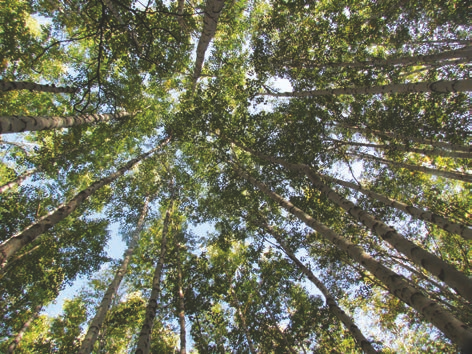
CANT: A log squared by taking off the bark covered slabs on all four sides.
CARBON SEQUESTRATION: Process that removes carbon dioxide from the atmosphere — trees, grasses and other plants uptake carbon dioxide during photosynthesis and store it in biomass.1
CHOKER: A steel cable strong enough to pick up and move a tree, log or section of wood and that attaches this tree part to the machine that is hauling it to a landing, such as a log skidder or cable yarding system.
CLIMAX FOREST: The final stage of forest succession, usually composed of shade-tolerant species that are self-perpetuating without a disturbance.2
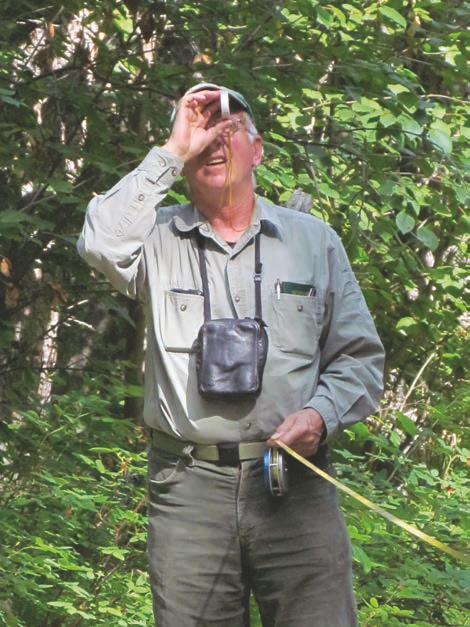
CLINOMETER: a device that measures the height of a tree or the steepness of a slope.
COMPETITION: The struggle between trees to obtain sunlight, nutrients, water and growing space. Every part of the tree — from the roots to the crown — competes for space and food.2
CONIFEROUS TREES: Cone-bearing trees with needles such as spruce, hemlock, cedar and pine.
CONSERVATION: The protection, improvement and wise use of natural resources for present and future generations.1
CONSERVATION EASEMENTS: A voluntary legal agreement between a landowner and a land trust or government agency that limits the use of the property in order to protect the conservation values of the land.1
CONTRACT (or CUTTING CONTRACT): A written, legally binding document used in the sale of standing timber. The contract specifies the provisions covering the expectations and desires of both the buyer and seller.4
CONTROLLED BURN (or prescribed burn): The use of fire under specific environmental conditions to achieve forest management objectives. Used to reduce hazardous fuel levels, control unwanted vegetation, favor desired vegetation (regenerate birch and aspen) and improve visibility and wildlife habitat.
COPPICE REGENERATION: Intentionally cutting trees for the express purpose of causing re-sprouting from the roots or the cut stump.2 Trees in Alaska that may regenerate by coppice methods are usually cut in winter when the tree is dormant and the sap is down in the roots and include aspen, balsam poplar and cottonwood. Willow species important for wildlife habitat also respond using the same coppice regeneration methods. This method is likely a clear cut, allowing these species to resprout uninhibited by residual trees of the same species, which can inhibit root sprouting if retained on the site. Coppice regeneration also mimics the effects of a hot wildfire, which also (if not so hot as to damage the roots) creates root sprouting of these species.
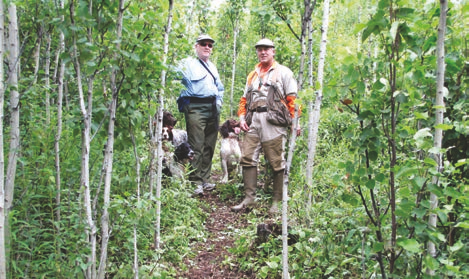
CORD: A measure of wood, usually associated with firewood or pulp, that is a stack 4 feet high, 4 feet wide and 8 feet long. It takes up a space that is 128 square feet and is usually associated with 90 cubic feet of solid wood.1
COST-SHARE ASSISTANCE: An assistance program offered by various state and federal agencies that pays a fixed rate or percentage of the total cost necessary to implement some forestry or agricultural practice.
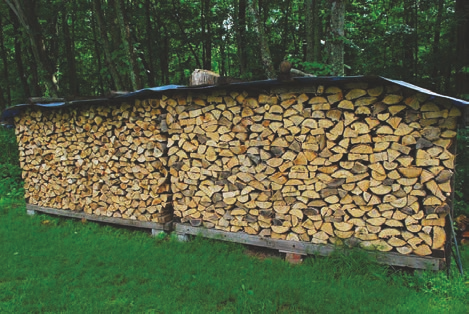
CROP TREE: A young tree of a desirable species with certain characteristics desired for timber value, water quality enhancement, wildlife habitat or aesthetic uses (as projected into the future).5
CROWN: The branches and foliage at the top of a tree.1
CROWN CLASS: A relative designation of tree crowns, broken into distinct layers:
Dominant Trees: Trees much taller than the general level of the canopy, receiving direct sunlight on all sides of their crown.
Co-dominant Trees: Trees that form the general level of the canopy but that are below the dominant trees. They receive sunlight from above their crown and some sunlight from the side.
Intermediate Trees: Trees with crowns that fall below the general level of the canopy. These trees receive minimal direct sunlight and then only at midday.
Suppressed Trees (Over-Topped Trees): Trees much shorter than the general level of the canopy, receiving only indirect sunlight filtered through the canopy above them.2
CULL TREE: A saw-timber-sized tree that has no timber value as a result of poor shape or damage from injury, insects or disease.4 A tree or log of merchantable size that is useless for all but firewood or pulpwood.5
DBH: Commonly referred to as the diameter-breast-height. This is the diameter taken at 4.5 feet above the ground, which is 1.3 to 1.5 meters or 52" to 59" above ground level measured from the uphill side of the tree trunk.
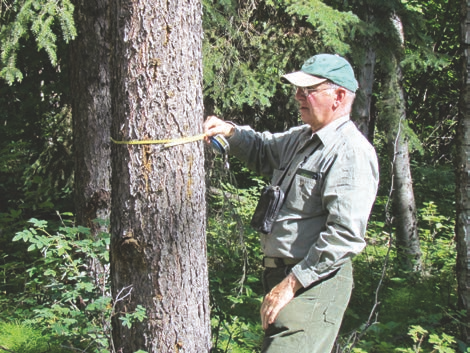
DECIDUOUS TREES: Those trees that lose their leaves during the dormant months like birch, aspen, poplar, cottonwood, alder and willow.2,5
DEN TREE: A tree that contains cavities, caused by abscised limbs or woodpeckers, that are used by wildlife for nesting and protection and are retained in the stand as wildlife habitat.2
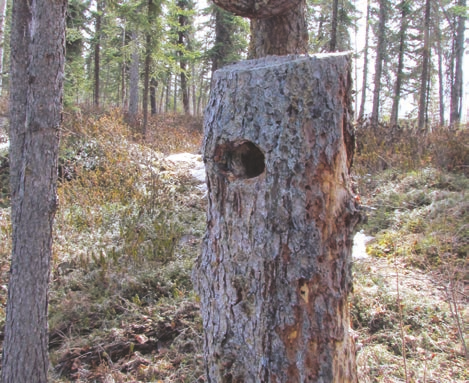
DENDROLOGY: The study of trees and other woody plants, including tree identification, and the natural history of individual tree species.
DIAMETER: Determining the diameter of a tree at DBH can be done by taking the circumference with a measuring tape and dividing that number by 3.14 (which is pi). If a tree measures 39" divide that by 3.14 and the diameter = 12.4". When measuring diameter to determine the volume of a tree or the volume of timber per acre, round the measured value down if it is .5" or less, and round up if it is more than .5". For example, if the diameter is 12.5" or less mark it down on your cruise notes as a 12.0" diameter tree. If the DBH is 12.6" or above write it down as 13.0".
DIAMETER TAPE: A tool used to measure the diameter of a tree, usually at breast height (see DBH). Made of cloth or steel, diameter tapes are used in forest inventory and timber cruising by passing the tape around the tree at 4.5 feet above the ground and reading the diameter (already calibrated on the tape) from it.
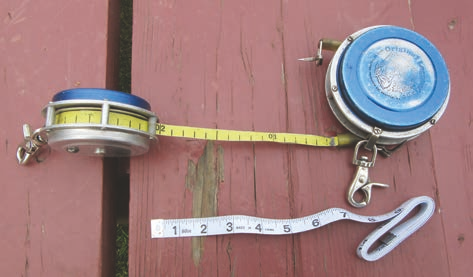
DISTURBANCE: A natural or human-caused action on the forest that causes the forest to regenerate back to an early stage of forest succession such as after a fire, flood, wind throw, avalanche, clear cutting, logging, site preparation, mortality from insect infestation, etc.
DOMINANT TREES: Trees that extend above surrounding individuals and capture sunlight from above and around their crown.5
DORMANT: Seasonal state of plant (usually winter) when there is no growth. Plants “break dormancy” in the spring when buds swell and new leaves and flowers begin to appear.
ECOLOGY: The science or study of the relationships between organisms and their environment.1
ECOSYSTEM: A biological community of living organisms and nonliving components such as air, water and mineral soil that interact. An ecosystem can be of any size — e.g., log, field, pond, woodlot, or earth’s biosphere.1 Also described as a loosely defined area consisting of numerous habitats.6
EDGE: The boundary or interface between two plant age classes, as in; between sapling sized birch and pole sized birch, or between two plant communities or between different landscape elements, as in: the transition between upland forest and wetland area.1
EVEN-AGED MANAGEMENT: A forest management method in which all trees in an area are harvested at one time or in several cuttings over a short time to produce stands that are all the same age or nearly so. This management method is commonly applied to shade-intolerant conifers and shade intolerant (faster growing) hardwoods (like birch, poplar, aspen).1 This management technique mimics regeneration most often occurring after a wildfire.
FELLER BUNCHER: A machine used in the harvesting process that can cut a tree, hold it, and move to the next tree to cut. After one or more trees are cut, the machine places the trees in a small pile to be moved to a landing.1
FELLING CUT (also see BACK CUT): The final cut made in felling a tree. Made on the opposite side of the direction of fall.4
FIREBREAK: Space cleared of flammable material to stop and/or check creeping or running fires. Any natural or constructed barrier used to segregate, stop and control the spread of fire or to provide a control line from which to work to suppress the fire.4
FIRE DANGER: Measure of the likelihood of a forest fire, based on temperature, relative humidity, wind force and direction, and the dryness of the woods.4
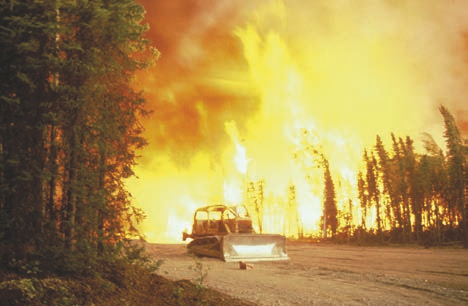
FIRE HAZARD: Condition of fuel on the ground, particularly slash.4 Fire hazard is often a combination coupled with weather conditions: temperature, fuel moisture content, relative humidity, wind speed and direction, slope percent and aspect (which way the slope is facing) and other factors of local importance.
FIRE LINE: Cleared area extending down to mineral soil that surrounds a fire to prevent the fire from reaching fresh fuels.4
FIVE-YEAR-SCHEDULE TIMBER SALES (FYSTS): A document required by regulations in the State of Alaska on state lands that determines the possibility of offering timber sales in a previously identified area. Tells the industry and general public what the state is thinking for future timber sale offerings. The FYSTS is usually updated every two years.
FOREST: A complex ecological system in which trees are the dominant life form.7 An area managed for the production of timber and other forest products or maintained as wood vegetation for such indirect benefits as protection of catchment areas or recreation.4 An ecosystem dominated by extensive tree cover, frequently consisting of stands of trees that are often characterized based on species, age and size class. Forests are often categorized based on their purpose: e.g., urban forest, industrial forest, nonindustrial private forest.1
FOREST FLOOR: the ground-level portion of a timber stand where seedlings and herbaceous and shrub vegetation grow.
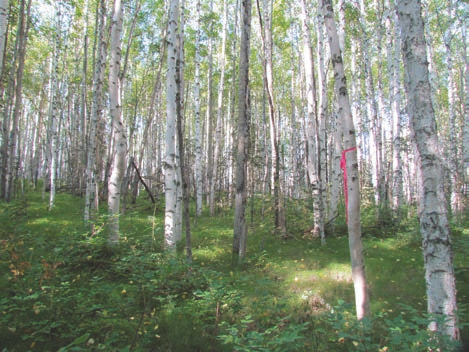
FOREST INVENTORY: A measure of tree/stand/forest vegetation by species composition, age class, growth rate, size class, condition, volume per acre, crown class characteristics, basal area measurements, wildlife species and use, fuel loadings, aspect, topographic feature etc. See Forestry Inventory Methods, Forestry Technical Note No. FOR-1, July 2018.
FORESTLAND: Land that has a minimum stocking level of 10% of forest trees and is at least 1 acre in size and 120 feet in crown width. This includes land that will be naturally or artificially regenerated.1
FOREST MANAGEMENT: The application of scientific, economic and social principles to managing a forest for accomplishing desired outcomes.2 Generally, the practical application of scientific, economic and social principles to the administration and working of a specific forest area for specified objectives.4
FOREST MANAGEMENT PLAN: Written guidelines for current and future management practices recommended to meet an owner’s objectives.1
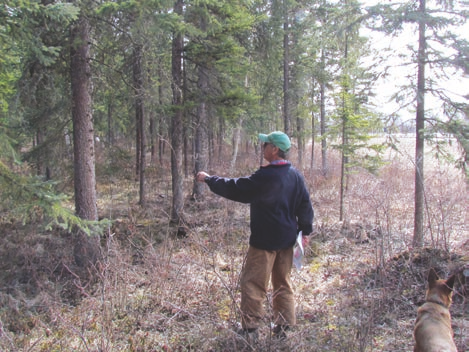
FOREST PRODUCTS: Any product that can be harvested or taken from the forest that provides income or sustenance to people for things or food needed to make our living.
Commercial Forest Products: Products harvested from trees in the form of lumber, logs, wood chips, pulp, biomass, firewood, chemicals etc. that produce revenue or benefits for personal use to people that manage or utilize these things from the forest. These products may be harvested from natural forests or plantations of trees.
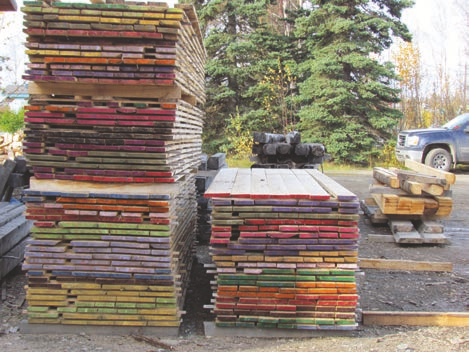
Non-Timber Forest Products (NTFP): Products not derived from the large-scale harvesting of trees for lumber, firewood, pulp etc. NTFPs can create revenue and/or subsistence products, including nuts, sap, medicinal products, kitchen tools, branch products, edible and medicinal mushrooms, bark implements, Christmas decorations, wildlife habitat, hunting and fishing trespass leases etc., as well as recreational, cultural and aesthetic resources.
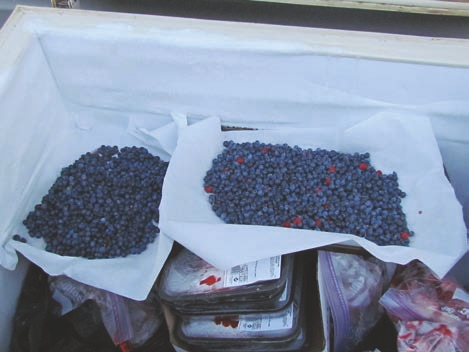
FOREST RESOURCES AND PRACTICES ACT (FRPA); FOREST RESOURCES AND PRACTICES REGULATIONS: See forestry. alaska.gov/. Set up by the Alaska State Legislature to protect and manage the forest resources of Alaska. Two booklets found on the State of Alaska Division of Forestry website.8
FOREST STEWARD PLAN: Usually under the FOREST STEWARDSHIP PROGRAM (see below). A written document of activities that enhance or improve forest resources, including wildlife, timber, soil, water, recreation and aesthetics, on private land over a five-year period.
FOREST STEWARDSHIP PROGRAM: Provides assistance to owners of forest land and other lands where good stewardship, including agro-forestry applications, will enhance and sustain the long-term productivity of multiple forest resources and produce healthy, resilient forest landscapes.9
FORESTER: A degreed professional trained in forestry and forest management.5 A person who practices the management of forested land, together with associated resources, primarily for harvesting timber. To a large degree, modern forestry has evolved in parallel with natural resource management. As a consequence, professional foresters have increasingly become involved in activities related to the conservation of soil, water, and wildlife resources and recreation.
FORESTRY: The art and science of managing forests to produce various products and benefits including timber, wildlife habitat, clean water, biodiversity and recreation for human benefit.1 Generally, a profession embracing the science, business, and art of creating, conserving, and managing forest and forest lands for the continuing use of their resources, materials and other forest products.4
FORESTRY INCENTIVES PROGRAM (FIP): A federal cost-sharing program that reimburses part of the costs landowners incur in completing certain program-approved forestry practices currently offered through programs administered by the Natural Resource Conservation Service (NRCS).5
FORWARDER: A tracked or wheeled vehicle able to pick up and load on itself limbed tree-length sections or logs and transport them off the ground and to a log landing where they are unloaded in specified piles according to end product for later truck transport to a processing facility.
FORWARDING: A harvesting function of hauling a log(s) completely off the ground from the stump to a landing by a forwarder.1 This technique is easier on the residual stand but forwarders are more expensive.
FROST CRACKS: Radial, longitudinal split in the wood of a tree, generally near the base of the bole, caused by internal stresses due to extremely cold weather.4
FUEL LOAD: Accumulations of forest debris easily ignited and of various sizes from small dead dry grass (highly flammable) to larger downed dead logs (difficult to put out) that can carry a wildfire and be difficult to manage once ignited.1
FUNGI: There are about 144,000 known species of organisms in the kingdom Fungi, including yeasts, rusts, smuts, mildews, molds and mushrooms. Fungi are among the most widely distributed organisms and are of great environmental and medical importance. Many fungi are free-living in soil or water; others form parasitic or symbiotic relationships with plants or animals. They often enter trees through the soil, roots or through wounds on the tree and cause decay.7
GIRDLING: The act of cutting or removing a ring of bark (including the inner bark) around the entire circumference of a tree trunk, resulting in the tree’s death.1 To encircle a tree with axe cuts or a saw kerf to sever the bark and cambium layer, thus killing the tree.4
HABITAT: An area in which a specific plant or animal can naturally live, grow, and reproduce. For wildlife, habitat is the combination of food, water, cover and space.4
IMPROVEMENT CUT: An intermediate cut made to improve the form, quality, health or wildlife potential of the remaining stand.1 Timber is sometimes used for sale as revenue or as personal use firewood by the landowner.
INCREMENT BORER: A tool used to bore into a tree’s trunk at DBH, allowing a core or cross section of wood to be removed and the annual rings of that tree to be counted for tree age and the width of the last 10 years (closest to the cambium) to be measured and compared to determine growth rate and volume gain projections on that core. Also described as a hollow auger-like tool with a screw bit used to remove core samples from trees.6
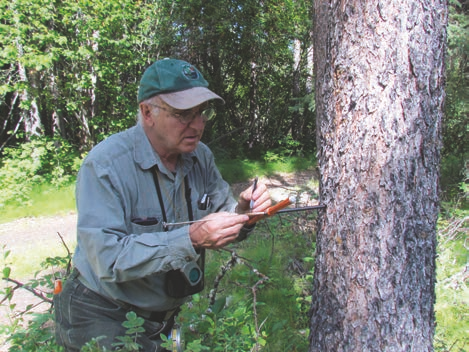
LIMITING FACTOR(S): Usually there is a most limiting factor inhibiting an organism (wildlife species, plant species etc.) from reaching its highest biological potential or population. Examples could be seasonal or topographic: deep snow, high population of predators, rainy or colder than normal spring weather, nesting cover, winter food sources etc.
LOG: A section of tree trunk cut to specified lengths for manufacture into a variety of forest products.
LOG LANDING: A designated area where harvested logs or trees are brought from where they were cut to be loaded onto trucks for transporting to a mill or processing center.1
LOGGING ROAD: A planned route through a timbered area that connects log landings with the main haul road or a public road going to timber processing facilities.
MERCHANTABLE HEIGHT: The height above the ground to which the tree bole can be cut and sold for commercial products, depending on species and markets.2 Sometimes standing trees are measured to this estimated height when determining volume.
NATURAL RESOURCE CONSERVATION SERVICE (NRCS): The branch of the U.S. Department of Agriculture that coordinates and implements soil conservation practices on private lands. The NRCS can provide woodland owners with detailed information on his or her soil.5
NICHE: The physical and functional “address” of an organism within an ecosystem; or, where a living thing is found and what it does there.5
NONINDUSTRIAL PRIVATE FORESTLAND (NIPF): Forestland owned by a private individual, group or corporation not specifically involved in wood processing.5
OLD-GROWTH FOREST: A wooded area, usually greater than 200 years of age, that has never been altered or harvested by humans. An old-growth forest often has large individual trees, a multilayered crown canopy, and a significant accumulation of coarse woody debris including snags and fallen logs.5
OVER-MATURE TREES: Trees that have declined in growth rate because of old age, loss of vigor and physical defects.5
OVERSTOCKED FOREST: A stand or forest condition indicating more trees than desired for the intended objective in a forest or stand.2 An overstocked stand suppresses many individual crop trees, keeping them from reaching their best overall growth and potential at final harvest.
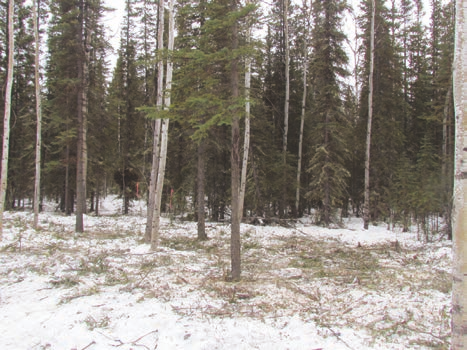
NORTHERN PACIFIC COASTAL TEMPERATE RAINFOREST: An ecoregion identified by some other similar names (Pacific Coast forest etc.) that encompasses a temperate coniferous forest along the Pacific coast of North America. It is a narrow coastal zone of Alaska between the Pacific Ocean and the northernmost Pacific Coast Ranges, extending from the Alexander Archipelago in Southeast Alaska along the Gulf of Alaska to the western Kenai Peninsula and eastern Kodiak Island. This ecoregion receives high rainfall and contains a quarter of the world’s remaining temperate rainforest. Tree species that may be found here include Sitka spruce, red and yellow cedars, hemlock species, shore pine and large alders. The entire Tongass National Forest, the largest national forest in the United States, is found here.10
PAY-AS-CUT SALE: Agreed-upon payments from the timber buyer/logger to the landowner for designated timber that is paid for on a per-unit basis as the timber is being harvested. This opposed to a lump-sum sale, where the timber is paid for in full before being harvested. For example, a landowner may divide their timber sale in thirds, marking three units in the field with paint or flagging and requiring the logger to pay for and cut the first unit entirely before moving on to other units in the timber sale area.
PLANTATION: A stand of trees made by planting tree seedlings.2
PLUG: Portion of an herbaceous plant including stems and leaves as well as roots or rhizomes with attached soil. Includes all plant parts necessary for survival and growth when transplanted.
PULLOUTS: Usually described in the logging contract, designated in the field and created by the logging contractor on logging roads and other secondary access roads to allow oncoming traffic to get out of the way of log trucks and other logging machinery per the landowner specifications; for safety and access purposes.
RIPARIAN MANAGEMENT: Article 2 Sec. 41.17.115 of the FRPA as pertains to riparian area protection within forest management regulations and guidelines.
RIPARIAN STANDARDS FOR PRIVATE LAND: To protect water resources and habitats related to forest management; see FRPA booklet Sec. 41.17.116, pages 11–13.
ROTATION: pertaining to the stand’s age at which it is finally completely harvested and begins to regrow an entire new stand of the same species in that forest. Example: birch may be cut on a 60-or 100-year rotation age depending upon the final expected end product such as wood chips or sawlogs.
SCALING (also called Log Scaling): Estimating the usable wood volume in a log, following fundamental rules.2 Logs are most often scaled on the ground using a scaling stick or tape that measures the log’s diameter inside the bark at the small end of the log. The scaling stick has gross volumes on it given the log’s diameter and length.
SHADE-INTOLERANT TREE SPECIES: Tree species that require full sunlight to grow and prosper. In Alaska, shade-intolerant tree species include birch, aspen, poplar, cottonwood, alder and willow species. These are species that cannot thrive in the shade of larger trees.4
SHADE-TOLERANT TREE SPECIES: Tree species that do not require full sunlight to grow and prosper. In Alaska, shade-tolerant species include white spruce and hemlock.
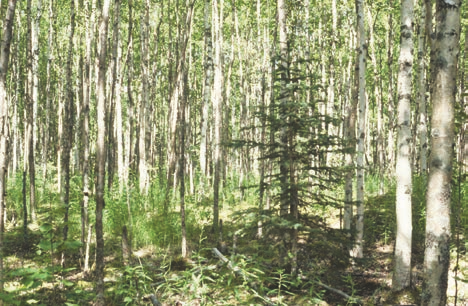
SILVICULTURE: “The art and science of controlling the establishment, growth, composition, health, and quality of forests and woodlands to meet the diverse needs and values of landowners and society on a sustainable basis” (Society of American Foresters). Applying knowledge of silvics to culture the forest. Silviculture is practiced in four stages: establishment, intermediate operations, harvesting and stand/forest protection.2
SILVICULTURIST: A forester who practices silviculture, usually practiced at the stand level on an individual stand basis taking into account the surrounding landscape.
SILVICULTURAL SYSTEM (Timber Harvest Method):
Clear Cutting: A harvesting and regeneration method removing all trees within a given area. Clear cutting is commonly used in pine and hardwood forests requiring full sunlight to regenerate and prosper.12 Timber is often harvested in Southeast Alaska using the clear-cut method because residual trees left in the stand often succumb to wind throw or severe damage See EVEN-AGED MANAGEMENT.
Selective Cutting: The periodic removal of individual trees or groups of trees to improve or regenerate a stand.1 See IMPROVEMENT CUTTING.
Seed Tree Harvest: A harvesting method in which a few scattered trees are left in the area to provide seed for a new forest stand. Selection of seed trees should be based upon growth rate, form, seeding ability, wind firmness and future marketability. This harvesting method produces an even-aged forest.4
Shelterwood harvest: Harvesting trees in a series of two or more operations. Following the first harvest, new seedlings grow and become established in the partial shade protection of older trees. Once established, the overstory trees are then harvested, yielding an even-aged stand.2
SKIDDER OR SKIDDING: Usually a diesel or gasoline powered wheeled or tracked machine that gathers cut trees and logs and transports them by dragging from one end, from the stump to the landing.
Cable Skidder: Usually a heavy rubber-tired tractor-type machine or dozer that uses one or more choker cables attached to a main line that is attached to an arch or drum on the skidder to winch one end of a log to the skidder, often just off the ground, and skid the logs toward the landing.
Grapple Skidder: A similar machine to above, this skidder has a large grapple or log tongs that picks up one or more logs individually or in a bunch, lifting one forward end off the ground and skidding the logs or trees to the landing.
SKID TRAIL: An access usually planned and described within the operating plan that allows the moving of cut timber from the stump to the landing for later transport to a processing facility like a sawmill.
SPRUCE BARK BEETLE: A serious spruce forest mortality factor south of the Alaska Range. Spruce beetle larvae kill the tree by girdling its inner cambium, shutting off the tree’s food supply. They are small, cylindrical beetles of the family Scolytidae, the adult of which bores into and beneath the bark of various trees to lay eggs.8,4
STOCKING: A relative term indicating the amount of growing space being occupied by trees and the amount of growing space available or unoccupied. Collective factors contribute to stocking guides, including basal area per acre, number of trees per acre and average tree diameter by species. Relative terms, such as overstocked, fully stocked or understocked, are descriptive terms to describe stocking. For best stand growth, stocking should be maintained in the fully stocked range.2
Overstocked Stand: A stand that is overcrowded, beyond 100 percent stocking, thus reducing overall tree growth and vigor for trees in that stand.
Fully Stocked Stand: A stand where trees effectively occupy most of the growing space, yet space remains for further crown expansion and growth of developing crop trees. For example, a stand fully stocked at 70 percent can grow suitably until it reaches 100% stocking.
Understocked Stand: A stand in which crop trees do not fully occupy the growing space in that stand and their form or grade may be diminished because of that fact.
SUCCESSION: The natural sequence of plant community replacement beginning with bare ground and resulting in a final, stable community in which a climax forest is reached. Foresters, wildlife biologists and farmers constantly battle ecological succession to try to maintain a particular vegetative cover.
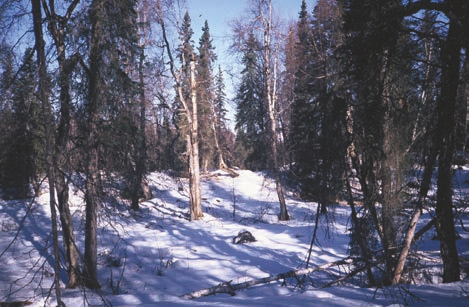
SUSTAINED YIELD: The achievement and maintenance in perpetuity of a high-level annual or regular periodic output of the various renewable resources of a stand without significant impairment of the productivity of the land and water, but does not require that timber be harvested in a nondeclining yield basis over a rotation period (see FRPA booklet above, page 25).8
THINNING: Tree removal in an immature forest stand that reduces tree density and between-tree competition. Proper thinning encourages increased growth of fewer but higher quality trees.2 Thinning concentrates growth on fewer, high-quality trees, may provide periodic income, and generally enhances tree vigor. Heavy thinning can benefit wildlife through the increased growth of ground vegetation.4
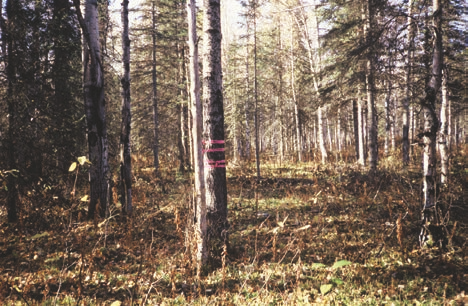
TIMBER CRUISE: The act of inventorying a forest (most often by a trained forester or technician) to arrive at an estimate of wood volume and value and/or to make forest management recommendations.2 Also, a forest survey used to obtain inventory information and develop a management plan.5 There are several methods and means of doing a timber cruise based on the value of the timber, size, condition, species etc.
TIMBER SALE CONTRACT: Most often a written contract between the forest landowner who owns standing timber and a licensed, insured professional logger who will cut and remove timber in a specified manner and within a timeframe agreed upon by both. Money or compensation is agreed upon by both parties within a timber sale contract. TIMBER SALE INSPECTIONS: A field inspection done by the forest landowner or representative periodically through the activity of the timber sale to make sure the logger is abiding by the terms set forth in the timber sale contract. A written report is most often submitted after the field inspection to the forest landowner to help them keep track of the operation and its compliant operation. Inspections should be done often enough for the forest landowner to maintain control of the outcome on the timber sale.
TIMBER STAND IMPROVEMENT (TSI): Improving the quality of a forest stand by removing or killing undesirable species to achieve desired stocking and species composition. TSI practices include applying herbicides, burning, girdling, or cutting.
TREE CUTTING: Usually accomplished in this case with a sharp chainsaw:
Face Cut: On the side of the tree facing the direction the tree is being felled, the face cut is made in two parts. Each cut into the trunk is to go no more than ¼ to 1/3 of the way into the trunk. One cut is made angling down, the other cut is level or angles upward and both meet exactly. A wedge-shaped piece is formed and is often called a bird’s beak. The bird’s beak is removed from the tree when both cuts meet.
Felling Cut: After the face cut is made (and the pie-shaped piece that is formed making it is removed), the felling cut is made on the opposite side of the tree and 1 inch above where both cuts of the face cut meet. This cut is made flat, without any angle, toward the face cut and is backed by inserting a wood or plastic felling wedge into the saw cut made forming the felling cut. The felling wedge keeps the chainsaw cutting bar from being pinched and stuck as the cut progresses. The felling cut proceeds to within approximately 1-inch from the back of the face cut and should not meet the face cut. The felling wedge should remain firmly within the felling cut. The tree should begin falling when the felling cut approaches the face cut where it forms a 1-inch hinge where the three cuts approach each other. Do not cut all the way through the hinge or the tree could fall in an unintended direction.
Bucking: The action of cross-cutting the tree against the grain or across the log into useful logs or firewood.
Limbing: The act of removing limbs from a felled tree to leave a limb-free log or firewood pieces. TREE
HEIGHT:
Merchantable Tree Height: Most often used when someone is involved in determining the volume of useful wood in evergreen conifers where the height of a tree is estimated or measured to a certain diameter depending on end product specifications. Pulpwood trees may be estimated to a 4-inch top, saw timber may be estimated to an 8-inch top etc.
Total Tree Height: Described as the height of a tree measured from a one-foot-tall stump to the very top of the tree. This measurement can be compared to locally produced volume tables for that species where the gross volume (not including defect or any deductions) is given. Any deductions can be made for rot, crooks, excessive taper etc. by consent at the end of volume determination for that stand or on an individual tree by tree basis.
TREE SIZE CLASS: Tree size classes arranged by various sizes according to their descriptive forest products.
Seedling: Usually a young tree planted or naturally regenerated that is from 1 to 10 years of age and less than 1 inch in diameter.
Sapling: A tree that is from 1 to 5 inches in diameter.
Pole: A tree or tree part that is from 5 to 9 inches in diameter.
Sawlog: A log or tree large enough to produce a sawn product. Usually at least 10 inches in diameter at the small end of the log and from 8 feet to 16 feet long. Saw timber is a tree that can produce at least one log at least 8 feet long and 10 inches in diameter at the small end of that log.
TREE VOLUME UNITS:
Board Foot: A unit of measure equal to a board that is 1 inch thick, 12 inches long and 12 inches wide, or 144 cubic inches.1 For example, a piece of wood measuring 1 foot by 2 inches by 6 inches contains 1 board foot of wood.2
Cord: A measure of wood usually associated with firewood or pulp that is a stack 4 feet high, 4 feet wide and 8 feet long. It takes up a space that is 128 square feet but is usually associated with 90 cubic feet of solid wood.1 Cunit: A metric unit that is 100 cubic feet of solid wood and is approximately 1.1 cords of wood.
Log Rules: Also called international rule, ¼-inch rule, Doyle’s rule, Scribner decimal C, etc. Several formulas used to estimate lumber volume in board feet based on the log’s length and the diameter at the small end of the cut log.2 For example, the log rule most often used in the Matanuska-Susitna Valley of Southcentral Alaska is the Scribner Decimal-C rule. Often the rule used is selected by general local consent and indicates what is accepted and generally agreed upon in that part of the country where it is used. Timber buyers often adjust their bid on standing timber based on what their sawmill is able to make from the wood they purchase. Each rule will have its own set of log scale tables.
Lineal Foot: A log measure used for determining poles, house logs etc.
WATERSHED: An area of land that collects and discharges water into a single stream or other outlet.4
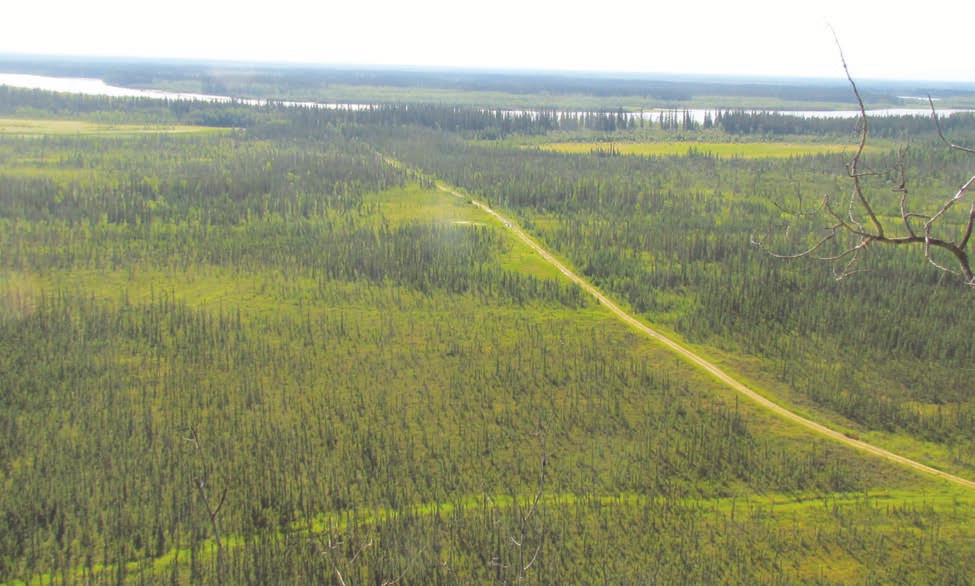
References
- Understanding Forestry Terms: A Glossary for Private Landowners. North Carolina State University Extension. https://content.ces.ncsu.edu/understanding-forestry-terms-a-glossary-for-private-landowners
- A Glossary of Common Forestry Terms. University of Tennessee Extension Institute of Agriculture 17-0152, 09/17, W428. PDF download
- Helms, J. 1998. The Dictionary of Forestry. Society of American Foresters, Bethesda, MD.
- Glossary of Forest Engineering Terms. USDA Forest Service, Forest Operations Research. RWU-4703, Southern Research Station, Asheville, NC. https://www.srs.fs.usda.gov/forestops/glossary/
- Glossary of Forestry Terms. Maryland Department of Natural Resources. https://dnr.maryland.gov/forests/pages/gloss.aspx
- Glossary of Forestry Terms. North Carolina Forestry Association. https://www.ncforestry.org/education/education-materials/glossary-of-forestry-terms
- Encyclopedia Britannica. www.britannica.com
- State of Alaska Division of Forestry. forestry.alaska.gov
- Woodlandinfo.org. https://woodlandinfo.org/timber-sales-harvest-and-sell-trees-with-success/
- Wikipedia
- U.S. Forest Service website, Forest Inventory and Analysis. https://www.fs.usda.gov/research/programs/fia
This publication was paid for by the Renewable Resources Extension Act (RREA).
In accordance with Federal law and U.S. Department of Agriculture (USDA) civil rights regulations and policies, this institution is prohibited from discriminating on the basis of race, color, national origin, sex, age, disability, and reprisal or retaliation for prior civil rights activity. (Not all prohibited bases apply to all programs.) Program information may be made available in languages other than English. Persons with disabilities who require alternative means of communication for program information (e.g., Braille, large print, audiotape, and American Sign Language) should contact the responsible State or local Agency that administers the program or USDA’s TARGET Center at (202) 720-2600 (voice and TTY) or contact USDA through the Federal Relay Service at (800) 877-8339. To file a program discrimination complaint, a complainant should complete a Form AD-3027, USDA Program Discrimination Complaint Form, which can be obtained online at https://www.ocio.usda.gov/document/ad-3027, from any USDA office, by calling (866) 632-9992, or by writing a letter addressed to USDA. The letter must contain the complainant’s name, address, telephone number, and a written description of the alleged discriminatory action in sufficient detail to inform the Assistant Secretary for Civil Rights (ASCR) about the nature and date of an alleged civil rights violation. The completed AD-3027 form or letter must be submitted to USDA by: (1) Mail: U.S. Department of Agriculture Office of the Assistant Secretary for Civil Rights 1400 Independence Avenue, SW Washington, D.C. 20250-9410; or (2) Fax: (833) 256-1665 or (202) 690-7442; or (3) Email: program.intake@usda.gov. This institution is an equal opportunity provider.
Glen Holt, Forester, Cooperative Extension Service
New June 2021
